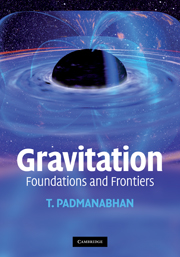Book contents
- Frontmatter
- Contents
- List of exercises
- List of projects
- Preface
- How to use this book
- 1 Special relativity
- 2 Scalar and electromagnetic fields in special relativity
- 3 Gravity and spacetime geometry: the inescapable connection
- 4 Metric tensor, geodesics and covariant derivative
- 5 Curvature of spacetime
- 6 Einstein's field equations and gravitational dynamics
- 7 Spherically symmetric geometry
- 8 Black holes
- 9 Gravitational waves
- 10 Relativistic cosmology
- 11 Differential forms and exterior calculus
- 12 Hamiltonian structure of general relativity
- 13 Evolution of cosmological perturbations
- 14 Quantum field theory in curved spacetime
- 15 Gravity in higher and lower dimensions
- 16 Gravity as an emergent phenomenon
- Notes
- Index
3 - Gravity and spacetime geometry: the inescapable connection
Published online by Cambridge University Press: 05 June 2012
- Frontmatter
- Contents
- List of exercises
- List of projects
- Preface
- How to use this book
- 1 Special relativity
- 2 Scalar and electromagnetic fields in special relativity
- 3 Gravity and spacetime geometry: the inescapable connection
- 4 Metric tensor, geodesics and covariant derivative
- 5 Curvature of spacetime
- 6 Einstein's field equations and gravitational dynamics
- 7 Spherically symmetric geometry
- 8 Black holes
- 9 Gravitational waves
- 10 Relativistic cosmology
- 11 Differential forms and exterior calculus
- 12 Hamiltonian structure of general relativity
- 13 Evolution of cosmological perturbations
- 14 Quantum field theory in curved spacetime
- 15 Gravity in higher and lower dimensions
- 16 Gravity as an emergent phenomenon
- Notes
- Index
Summary
Introduction
In the previous chapter we described how the dynamics of the scalar and vector fields can be described in a manner consistent with the special theory of relativity. Given the fact that Newtonian gravity is described by a gravitational potential φN(t, x), which satisfies the Poisson equation ∇2φN = 4πGρm (where ρm is the mass density), it might seem that one could construct a theory for gravity consistent with special relativity by suitably generalizing the Poisson equation for the gravitational potential. It turns out, however, that this is not so straightforward. The natural description of the gravitational field happens to be completely different and is intimately linked with the geometrical properties of the spacetime. We will be concentrating on such a description from Chapter 4 onwards in this book.
The key purpose of the present chapter is to explain in physical terms why such a geometrical description for gravity is almost inevitable. We shall first describe several difficulties that arise in any attempt to provide a purely field theoretic description of gravity in flat spacetime. We will then give a series of simple thought experiments that illustrate an intimate connection between gravitational fields and spacetime geometry. None of this can be thought of as a mathematically rigorous proof that gravity must be described as spacetime geometry; however, it goes a long way in showing that such a description is most natural and, of course, consistent with all known facts about gravity.
- Type
- Chapter
- Information
- GravitationFoundations and Frontiers, pp. 107 - 135Publisher: Cambridge University PressPrint publication year: 2010



